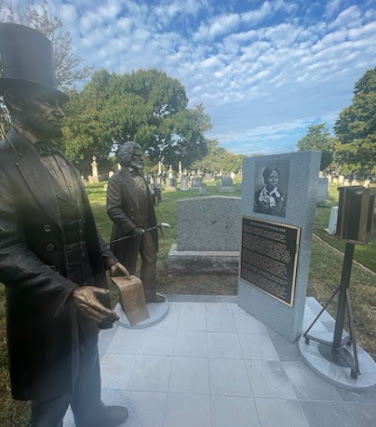 |
| A partial view of the memorial depicts Brady in foreground (Congressional Cemetery) |
Photo historian Larry West spearheaded the effort to honor Brady, who died destitute in 1896 and was buried in Congressional Cemetery. The photographer is remembered for his depictions of famous and everyday Americans, and battlefield scenes that brought the horrors of war to American's doorsteps.
 |
| Matthew B. Brady |
“The memorial features Mathew, recognizing him as the entrepreneur, innovator, team leader and posing artist that he was,” West wrote the Picket in an email this week.
While it does not include
his famous scenes from the Antietam and Gettysburg battlefields and those of campsites, many of the
porcelains depict people who were wartime figures.
Historians
this year are marking Brady’s 200th birthday, emphasizing his
importance to the field of photojournalism.
“Brady’s
photographs of Gettysburg caused a sensation when viewed by members of the
public,” says Congressional Cemetery. “Americans were little used to scenes
of war that before had only existed in imagination.
“The prior
year, in 1862, Brady had shocked the public when he exhibited photographs of
dead enemy soldiers, captured by associates Alexander Gardner and James M.
Gibson, from the Battle of Antietam.”
 |
| Lincoln, Douglass and Anna Murray-Douglas (Congressional Cemetery) |
Eventually, the government purchased Brady's photographs for $25,000, providing him some financial relief. Fortunately, most are available on the Library of Congress website.
Upon his passing in 1896, veterans of the 7th New York Infantry helped finance Brady's funeral and interment at Congressional Cemetery.
 |
| Sept. 17 dedication in southeast Washington (Congressional Cemetery) |
West, a board member of Congressional Cemetery, designed and provided primary financial backing for the memorial.
“Celebrating Brady's outstanding artistic achievements, the memorial reflects the diversity of his subjects and the Washington, D.C. community,” a Facebook post says.
Congressional Cemetery, founded early in the 19th century, has graves of Washington residents and numerous national figures.
It is the final resting place for about 600 Union service members and 100 Confederates.
“Generals
lie next to privates, and brothers who fought on opposite sides rest only a few
feet apart.”
Among those buried there are Alfred Pleasanton, a Union cavalry general, Maj. Gen. Andrew Humphreys and executed Lincoln conspirator David Herold.
Visitors can take a self-guided, Civil War-themed walking tour.

No comments:
Post a Comment